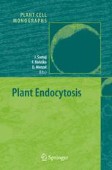Search
Search Results
-
Endocytosis and Actomyosin Cytoskeleton
Mutual interactions between actin and endocytic assembly machineries are essential for successful clathrin-mediated endocytosis in yeast and...
-
Endocytosis and Membrane Recycling in Pollen Tubes
In plants, tip-growing cells are an ideal system to investigate signal transduction mechanisms and, among these, pollen tubes are one of the...
-
Plant Prevacuolar Compartments and Endocytosis
Prevacuolar compartments (PVCs) are membrane-bound organelles mediating protein traffic from both Golgi and plasma membrane to vacuoles in...
-
Importance of Cytoskeleton and Cell Wall in Somatic Embryogenesis
Both the cytoskeleton composed of microtubules and actin microfilaments as well as cell wall components such as arabinogalactan proteins and...
-
Ions and Pollen Tube Growth
Ions play a crucial role in the control of pollen tube growth. In this review we focus on four that seem especially important: calcium (Ca...
-
Comparative Analysis of Biological Models used in the Study of Pollen Tube Growth
The mechanisms of pollen tube growth have been studied in a wide variety of plant species. Since the 1990s, with the explosion of molecular...
-
Gametic Embryogenesis in Triticum: a Study of Some Critical Factors in Haploid (Microspore) Embryogenesis
This review of embryogenesis from microspores in two types of wheat examines the influences of various procedures used to induce and produce...
-
The Roles of Chromatin Remodelling Factors in Replication
Dynamic changes of chromatin structure control DNA-dependent events, including DNA replication. Along with DNA, chromatin organization must be...
-
Structure and Function of Protein Modules in Chromatin Biology
Chromatin-mediated gene transcription or silencing is a dynamic process in which binding of various proteins or protein complexes can displace...
-
Comparative genomics and gene finding in fungi
In the spring of 2005, we had access to 18 fully sequenced fungal genomes, and more are coming rapidly. New approaches and methods are being...
-
Energy metabolism, anti-oxidant defense and aging in Caenorhabditis elegans
Food restriction and impaired gene function by mutation or RNAi treatment can extend the lifespan of Caenorhabditis elegans considerably. In contrast...
-
Do green plants age, and if so, how?
Time-dependent ageing-like processes in green plants are discussed and compared to gerontological changes in animals and other organisms. The...
-
Molecular responses of higher plants to dehydration
A massive amount of data has been accumulating on the molecular responses of plants to water deficit. In plants, dehydration activates a protective...
-
Heavy metal signalling in plants: linking cellular and organismic responses
Heavy metals are required in plants as essential micronutrients or act as toxic compounds. How do plants perceive heavy metals and which signalling...
-
Introduction
Everywhere in the world, environmental stresses represent the most limiting factors for agricultural productivity. Besides plant-specific endogenous...
-
Conditional senescence in prokaryotes
Bacteria are immortal in the sense that their capacity for reproduction appears limitless as long as the environment supports growth. However, this...
-
10 Sphingosine-1-phosphate metabolism in mammalian cell signalling
Sphingosine-1-phosphate (S1P) is a bioactive sphingolipid metabolite implicated in the regulation of vital biological processes. Ample evidence...
-
8 Biosynthesis and compartmentation of triacylglycerol in higher plants
The biosynthesis of storage lipids (triacylglycerols) in higher plants is now known to occur via a number of different routes. These include the...
-
Introduction: Lipids: cellular glue...or are they more than that?
Some 40 years ago, there was a rumor in the research community that lipids are the stuff you have to throw away before starting biochemical...
-
Zygocin – a monomeric protein toxin secreted by virus-infected Zygosaccharomyces bailii
Zygocin, a protein toxin secreted by virus-infected strains of the osmotolerant spoilage yeast Zygosaccharomyces bailii kills a broad spectrum of...
